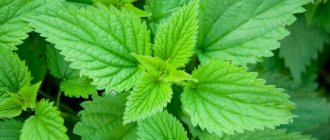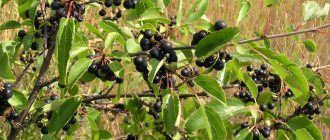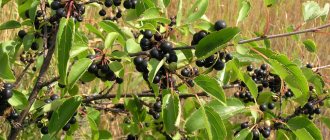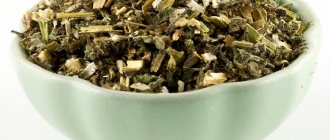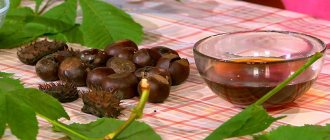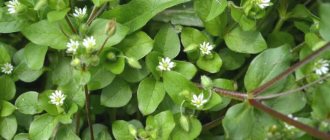Eleutherococcus senticosus (Eleutherococcus senticosus, Aralia Manchurian, devil's bush, Siberian ginseng) is an extremely thorny shrub from the Araliaceae family. The thorns of the plant are thin, long, directed downwards and very brittle. It is impossible to collect raw materials without splinters. Dense, bristling bushes are suitable for growing as a hedge or along a fence.
Eleutherococcus can grow for more than fifty years in one place
Description of the plant (description of the plant and species)
Eleutherococcus is a perennial plant that can grow for more than fifty years in one area. The height of the bush reaches an average of 2.5 m, sometimes up to 5 m. The leaves (main and additional) are light green, pubescent, with a tint and a complex configuration. Each leaf is attached to the branches with a long petiole. One bush has up to 25 branching shoots studded with thorns. Eleutherococcus spiny rhizomes and roots reach a total of 30 m.
The plant blooms in July and has a very strong specific aroma. At the end of the branch an absolutely round umbrella of white small flowers appears. The flowers are of three sexes at the same time: male (yellowish), female and bisexual (light purple). In September-October, instead of inflorescences, black fruit balls with yellow seeds ripen. The inedible berries are called drupes because of the seeds inside. The roots of Eleutherococcus are used as medicine.
This is what the fruit of Eleutherococcus looks like
The scientific study of the root of eleutherococcus was carried out by the Research Institute of Biological Compounds in Vladivostok in the middle of the last century. The reason for starting the study was that during a taiga expedition, scientists noticed increased attention of animals to bushes. They ate not only leaves and thorny branches, but even roots. Research has proven the uniqueness and medicinal properties of Eleutherococcus. At that time, preparations from the bush were used to prepare athletes from the Olympic team, divers, and for the immunity of astronauts after working in extreme extraterrestrial conditions.
Growing Eleutherococcus in the garden
Landing in the ground
Eleutherococcus is shade-tolerant and undemanding to soil composition, but it develops better in light shade under a large deciduous tree on moist, fertile soils. In the middle zone, the plant does not require shelter for the winter.
In the photo: Eleutherococcus berries
It is best to plant eleutherococcus in the fall, immediately after leaf fall, or in the spring, before the buds awaken on the trees. The area is cleared of weeds in advance and dug up to a depth of 25 cm, adding 5-6 kg of manure per m² for digging. The bushes are planted in pits 50 cm deep and 60 cm in diameter at a distance of 2 m from each other. The seedlings are placed in the center of the hole and the remaining space is covered with soil fertilized with manure, while the root collar is buried no more than 3 cm. After planting, the surface of the trunk circle is slightly compacted and generously watered with a weak solution of potassium permanganate.
Considering that seedlings can only have male or female flowers, it is advisable to plant several eleutherococcus bushes on the site in close proximity to each other. If planting is carried out in the fall, with the onset of stable cold weather, the tree trunk circles are mulched with a layer of humus up to 3 cm thick in order to protect the root system of plants from low temperatures.
Seedlings usually bloom in the fourth year after planting.
Rules of care
Eleutherococcus is watered only during drought, but unlike other garden plants, it does not require frequent weeding or loosening of the soil in the tree trunk circle: growing weeds protect the soil above the roots from overheating, without harming the plant. For this purpose, it is best to plant bentgrass or another non-aggressive ground cover plant around the bush.
Once a season, Eleutherococcus is fed with a solution of 2 tablespoons of complex mineral fertilizer in 10 liters of water.
- Method of sowing small seeds using the example of viola
Eleutherococcus is usually pruned in the spring for sanitary purposes: branches and shoots that are frozen, broken, damaged by pests, or growing inside the bush are removed. You can also do light formative pruning to make the bush look neat.
Pests and diseases
Eleutherococcus is not affected by any diseases or pests.
Chemical composition
The chemical composition of the bush has been confirmed by scientific research. The roots contain:
- vitamins E, D, A, C, B1.
- eleutherosides - aromatic alcohol;
- essential oils;
- polysaccharides;
- flavonoids;
- tannins;
- sterols (b-sitosterol, daucosterol, triterpenoids);
- vegetable wax;
- coumarin;
- oleic acid.
The most valuable substances - eleutherosides (glycosides) are found only in Eleutherococcus senticosus. The substance increases mental and physical performance, improves metabolism in the body, increases vision and hearing, and blood pressure.
The effect of eleutherococcus on the human body is similar to the effect of ginseng root
Customer Reviews
What do real people think about Eleutherococcus?
Feedback on the forum
Feedback on the forum
Feedback on the forum
Feedback on the forum
Feedback on the forum
Feedback on the forum
There are many reviews and they are all positive.
Spreading
Wild eleutherococcus bushes grow in Japan, China, Korea and Russia. In Russia, the plant is found only in the Far East: the Amur region, Primorye, Sakhalin.
Prefers to settle on mountain slopes, along rivers and in sufficiently illuminated forest areas. In cedar, fir and deciduous forests it forms an impenetrable undergrowth on the rich forest floor under the obligatory condition of high humidity. The plant loves partial shade. In a dense and dark forest, individual individuals survive. The closer to the south, the higher the plant climbs. Some species grow in the mountains at an altitude of 1000 m above sea level. Eleutherococcus can be found in your garden. It takes root well if the necessary conditions are created.
Preparations from Eleutherococcus were used to train athletes, divers and for the immunity of astronauts
Application
Eleutherococcus is included in the register of medicines in Russia. The effect of Eleutherococcus on the body has led to its use in the following areas:
- Official medicine - in the form of tablets, herbal mixture, Eleutherococcus extract, biostimulant for sports, dietary supplements.
- Cosmetology - for the treatment of hair and skin diseases.
- Veterinary medicine - for the treatment of animals.
- Gardening and landscape design - as decorative park bushes.
- In folk medicine, decoctions and teas are prepared from leaves, shoots and roots that fill a person with vigor.
An unexpected solution to what Eleutherococcus is used for turned out to be:
- energy drinks produced by the food industry;
- in bodybuilding to improve performance;
- if you need to quickly gain weight.
The area of using the beneficial capabilities of the plant is constantly increasing.
Medicinal properties and harm
The effect of eleutherococcus on the human body is similar to the effect of ginseng root. It affects the male and female body differently (the features are presented in the table).
Female body:
- normalizes the menstrual cycle;
- regulates hormonal levels;
- facilitates the course of menopause;
- reduces frigidity (sexual infantilism);
- increases the chance of conception.
Male body:
- improves erection;
- improves blood flow in the pelvis;
- normalizes the psycho-emotional state;
- eliminates physical stress;
- prevention of prostate adenoma (helps alleviate age-related changes).
Eleutherococcus does not act instantly; the therapeutic effect is cumulative. The result should be expected no earlier than 3-4 weeks.
Medicines from Eleutherococcus are also used in the treatment of other diseases:
- infectious diseases (colds, flu, postpartum infections);
- after severe operations and chemotherapy during the recovery period;
- atherosclerosis in the initial stage;
- seborrhea of the skin;
- inflammation of the oral cavity;
- cancer tumors at stages 1-2;
- increased irritability;
- with reduced pressure, it restores the indicator to normal.
In addition to beneficial properties, preparations from Eleutherococcus also have contraindications:
- Eleutherococcus should not be taken while breastfeeding. The active components of the plant enter the milk, and therefore into the baby’s body.
- Not recommended for children under 12 years of age. Until this age, it is taken only as prescribed by a pediatrician.
- You should not take Eleutherococcus if you have hypertension. Drugs for high blood pressure further contribute to its increase.
- Cannot be taken while losing weight. The drugs increase appetite and promote weight gain.
- You should not consume Eleutherococcus in the afternoon if you have insomnia. The medicine activates the action of the central nervous system.
- If you are intolerant to the components of the plant, its use is strictly prohibited.
- For epilepsy.
- For heart failure.
Side effects from taking medications occur with a significant overdose and lead to increased excitability, dizziness, diarrhea, and less commonly, nausea. Benefit and harm are always somewhere nearby, so you should take medications as prescribed by your doctor, if indicated.
Eleutherococcus is included in the register of medicines of Russia
Contraindications
Preparations based on Eleutherococcus are contraindicated:
- With high blood pressure;
- Acute heart failure;
- With sleep disorders;
- With increased excitability;
- For arrhythmia;
- During exacerbation of chronic diseases;
- In case of individual intolerance.
Excessive use may cause side effects such as:
- Irritability;
- Sense of anxiety;
- Digestive disorder;
- Insomnia.
If at least one of these symptoms occurs, you must stop taking the drug.
Collection, preparation and storage
The most useful part of the bush is the root. Features of the workpiece:
- It is better to collect raw materials in late autumn, when the plant has accumulated the maximum amount of useful substances.
- Harvesting should not be carried out after prolonged rains, as the root will have a high water content.
- The process is not very simple due to the presence of thorns. The above-ground part is cut down to get to the root. It is necessary to carefully protect your hands, otherwise the thorns can cause serious inflammation. The roots are located in the ground at a depth of 30 cm, and sometimes become bare and protrude from the ground. In adult bushes, the root is twisted out or the entire root is dug up. In young plants, part of the root should be left for further growth. The wound inflicted on the bush must be covered with earth to protect it from mushrooms and animals.
- Wash the future raw materials, cut into small pieces and dry in a dryer at 80 degrees for an hour.
- Then the raw materials are dried in a ventilated place until ready. The dug up root appears smooth and shiny with slight protuberances.
The leaves are harvested during the flowering period of the bush in August. It should be dried in the shade in a draft, stored in a dry place.
It is impossible to collect raw materials without splinters

